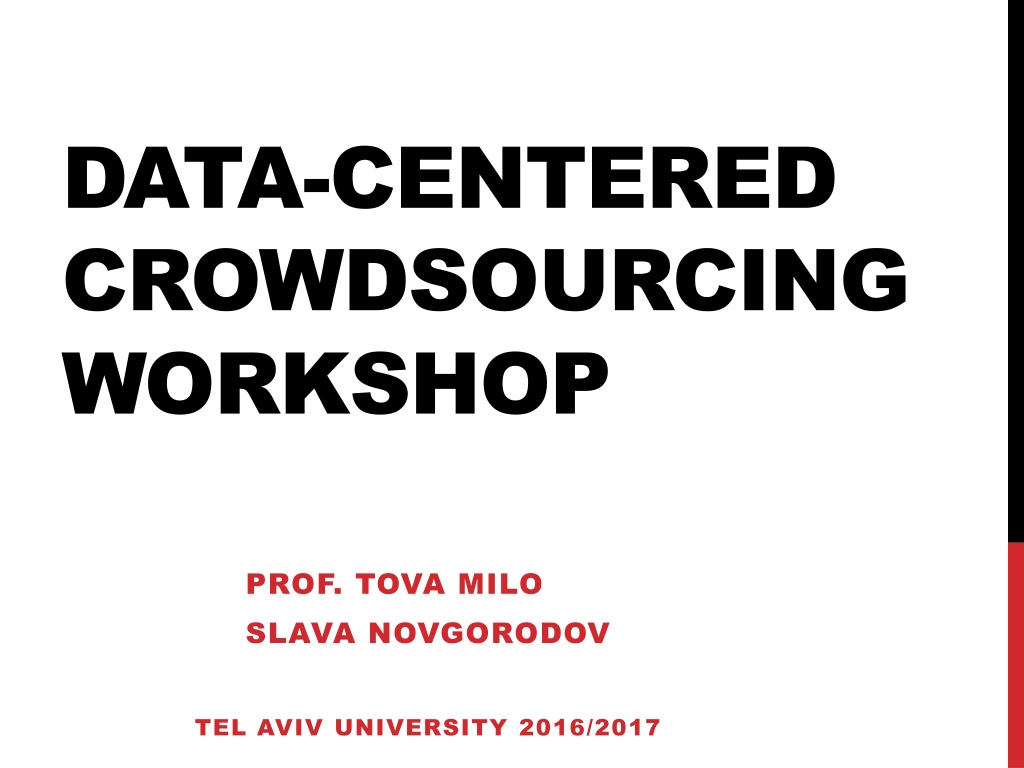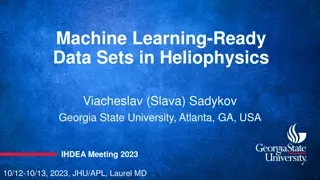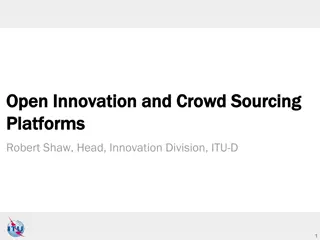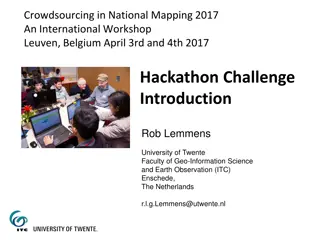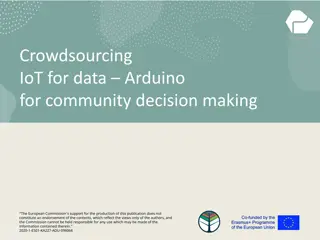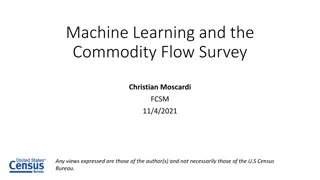Data-Centered Crowdsourcing Workshop with Prof. Tova Milo and Slava Novgorodov
Join the Data-Centered Crowdsourcing Workshop at Tel Aviv University to learn about crowd-data sourcing, improve existing solutions, and tackle new problems. The course covers databases, web programming, and more. Explore the principles and examples of crowdsourcing, understand its main goals and challenges. Get hands-on experience in harnessing the crowd for various tasks in this engaging workshop.
Download Presentation

Please find below an Image/Link to download the presentation.
The content on the website is provided AS IS for your information and personal use only. It may not be sold, licensed, or shared on other websites without obtaining consent from the author. Download presentation by click this link. If you encounter any issues during the download, it is possible that the publisher has removed the file from their server.
E N D
Presentation Transcript
DATA-CENTERED CROWDSOURCING WORKSHOP PROF. TOVA MILO SLAVA NOVGORODOV TEL AVIV UNIVERSITY 2016/2017
ADMINISTRATIVE NOTES Course goal: Learn about crowd-data sourcing and prepare a final project (improvement of existing problem s solution / solving new problem) Group size: ~4 students Requirements: DataBases (SQL) is recommended, Web programming (we will do a short overview), (optionally) Mobile development (we will not teach it)
ADMINISTRATIVE NOTES (2) Schedule: 3 intro meetings 1stmeeting overview of crowdsourcing 2ndmeeting open problems, possible projects 3rdmeeting Web programming overview Mid-term meeting Final meeting and projects presentation Dates: http://slavanov.com/teaching/crowd1617b/
WHAT IS CROWDSOURCING? Crowdsourcing = Crowd + Outsourcing Crowdsourcing is the act of sourcing tasks traditionally performed by specific individuals to a group of people or community (crowd) through an open call.
CROWDSOURCING Main idea: Harness the crowd to a task Task: solve bugs Task: find an appropriate treatment to an illness Task: construct a database of facts Why now? Internet and smart phones We are all connected, all of the time!!!
CROWDSOURCING: UNIFYING PRINCIPLES Main goal Outsourcing a task to a crowd of users Kinds of tasks Tasks that can be performed by a computer, but inefficiently Tasks that can t be performed by a computer Challenges How to motivate the crowd? Get data, minimize errors, estimate quality Direct users to contribute where is most needed \ they are experts
MOTIVATING THE CROWD Altruism Fun Money
CROWD DATA SOURCING Outsourcing data collection to the crowd of Web users When people can provide the data When people are the only source of data When people can efficiently clean and/or organize the data Two main aspects [DFKK 12]: Using the crowd to create better databases Using database technologies to create better crowd datasourcing applications [DFKK 12]: Crowdsourcing Applications and Platforms: A Data Management Perspective, A.Doan, M. J. Franklin, D. Kossmann, T. Kraska, VLDB 2011
MY FAVORITE EXAMPLE ReCaptha 100,000 web sites 40 million words/day
CROWDSOURCING RESEARCH GROUPS An incomplete list of groups working on Crowdsourcing: Qurk (MIT) CrowdDB (Berkeley and ETH Zurich) Deco (Stanford and UCSC) CrowdForge (CMU) HKUST DB Group WalmartLabs MoDaS (Tel Aviv University)
CROWDSOURCING MARKETPLACES
MECHANICAL TURK Requestor places Human Intelligence Tasks (HIT) Min price: $0,01 Provide expiration date and UI # of assignments Requestor approve jobs and payments Special API Workers choose jobs, do them and getting money
USES OF HUMAN COMPUTATION Data cleaning/integration (ProPublica) Finding missing people (Haiti, Fossett, Gray) Translation/Transcription (SpeakerText) Word Processing (Soylent) Outsourced insurance claims processing Data journalism (Guardian)
TYPES OF TASKS Source: Paid Crowdsourcing , SmartSheet.com
OVERVIEW OF RECENT RESEARCH Crowdsourced Databases, Query evaluation, Sorts/joins, Top-K CrowdDB, Qurk, Deco, Crowdsourced Data Collection/Cleaning AskIt, QOCO, . Crowd sourced Data Mining CrowdMining, OASSIS, Image tagging, media meta-data collection Crowdsourced recommendations and planning
CROWD SOURCED DATABASES Motivation: Why we need crowdsourced databases? There are many things (queries) that cannot be done (answered) in classical DB approach We call them: DB-Hard queries Examples
DB-HARD QUERIES (1) SELECT Market_Cap FROM Companies WHERE Company_Name = I.B.M Result: 0 rows Problem: Entity Resolution
DB-HARD QUERIES (2) SELECT Market_Cap FROM Companies WHERE Company_Name = Apple Result: 0 rows Problem: Closed World Assumption
DB-HARD QUERIES (3) SELECT Image FROM Images WHERE Theme = Business Success ORDER BY relevance Result: 0 rows Problem: Missing Intelligence
CROWDDB Use the crowd to answer DB-Hard queries Use the crowd when: Looking for new data (Open World Assumption) Doing a fuzzy comparison Recognize patterns Don t use the crowd when: Doing anything the computer already does well
CLOSED WORLD VS OPEN WORLD OWA Used in Knowledge representation CWA Used in classical DBMS Example: Statement: Marry is citizen of France Question: Is Paul citizen of France? CWA: No OWA: Unknown
CROWDSQL CROWD COLUMN DDL Extension: CREATE TABLE Department ( university STRING , name STRING , url CROWD STRING , phone STRING , PRIMARY KEY ( university , name ) );
CROWDSQL EXAMPLE #1 INSERT INTO Department (university, name) VALUES ( TAU , CS ); Result: University TAU Name CS Url CNULL Phone NULL
CROWDSQL EXAMPLE #2 SELECT url FROM Department WHERE name = Math ; Side effect of this query: Crowdsourcing of CNULL values of Math departments
CROWDSQL CROWD TABLE DDL Extension: CREATE CROWD TABLE Professor( name STRING PRIMARY KEY , email STRING UNIQUE , university STRING , department STRING , FOREIGN KEY ( university , department ) REF Department ( university , name ) );
CROWDSQL SUBJECTIVE COMPARISONS Two functions CROWDEQUAL Takes 2 parameters and asks the crowd to decide if they are equals ~= is a syntactic sugar CROWDORDER Used when we need the help of crowd to rank or order results
CROWDEQUAL EXAMPLE SELECT profile FROM department WHERE name ~= CS ; To ask for all "CS" departments, the following query could be posed. Here, the query writer asks the crowd to do entity resolution with the possibly different names given for Computer Science in the database.
CROWDORDER EXAMPLE SELECT p FROM Picture WHERE subject = Golden Gate Bridge ORDER BY CROWDORDER (p, Which picture visualizes better %subject ); The following CrowdSQL query asks for a ranking of pictures with regard to how well these pictures depict the Golden Gate Bridge.
UI GENERATION Clear UI is key to quality of answers and response time SQL Schema to auto-generated UI
QUERY PLAN GENERATION Query: SELECT * FROM d Professor p, Department d WHERE d.name = p.dep AND p.name = Karp
Qurk (MIT): Declarative workflow management system that allows human computation over data (human is a part of query execution)
QURK: THE BEGINNING Schema celeb(name text, img url) Query SELECT c.name FROM celeb AS c WHERE isFemale(c) UDF(User Defined Function) - isFemale: TASK isFemale(field) TYPE Filter: Prompt: "<table><tr> \ <td><img src= %s ></td> \ <td>Is the person in the image a woman?</td> \ </tr></table>", tuple[field] YesText: "Yes" NoText: "No" Combiner: MajorityVote
JOIN Schema photos(img url) Query SELECT c.name FROM celeb c JOIN photos p ON samePerson(c.img, p.img) samePerson: TASK samePerson(f1, f2) TYPE EquiJoin: SingluarName: "celebrity" PluralName: "celebrities" LeftPreview: "<img src= %s class=smImg>",tuple1[f1] LeftNormal: "<img src= %s class=lgImg>",tuple1[f1] RightPreview: "<img src= %s class=smImg>",tuple2[f2] RightNormal: "<img src= %s class=lgImg>",tuple2[f2] Combiner: MajorityVote
JOIN UI EXAMPLE # of HITs = |R| * |S|
JOIN NAVE BATCHING # of HITs = (|R| * |S|) / b
JOIN SMART BATCHING # of HITs = (|R| * |S|) / (r * s)
FEATURE EXTRACTION SELECT c.name FROM celeb c JOIN photos p ON samePerson(c.img,p.img) AND POSSIBLY gender(c.img) = gender(p.img) AND POSSIBLY hairColor(c.img) = hairColor(p.img) AND POSSIBLY skinColor(c.img) = skinColor(p.img) TASK gender(field) TYPE Generative: Prompt: "<table><tr> \ <td><img src= %s > \ <td>What this person s gender? \ </table>", tuple[field] Response: Radio("Gender", ["Male","Female",UNKNOWN]) Combiner: MajorityVote
ECONOMICS OF FEATURE EXTRACTION Dataset: Table1 [20 rows] x Table2 [20 rows] Join with no filtering (Cross Product): 400 comparisons Filtering on 1 parameter (say gender): +40 extra HITS For example: 11 females, 9 males in Table1 10 females, 10 males in Table2 Join after filtering: ~100 comparisons No-Filter/Filter HITs ratio: 400/140 Decrease the number of HITs ~ 3x
POSSIBLY FILTERS SELECTION Gender?
POSSIBLY FILTERS SELECTION Skin color?
POSSIBLY FILTERS SELECTION Hair color???
